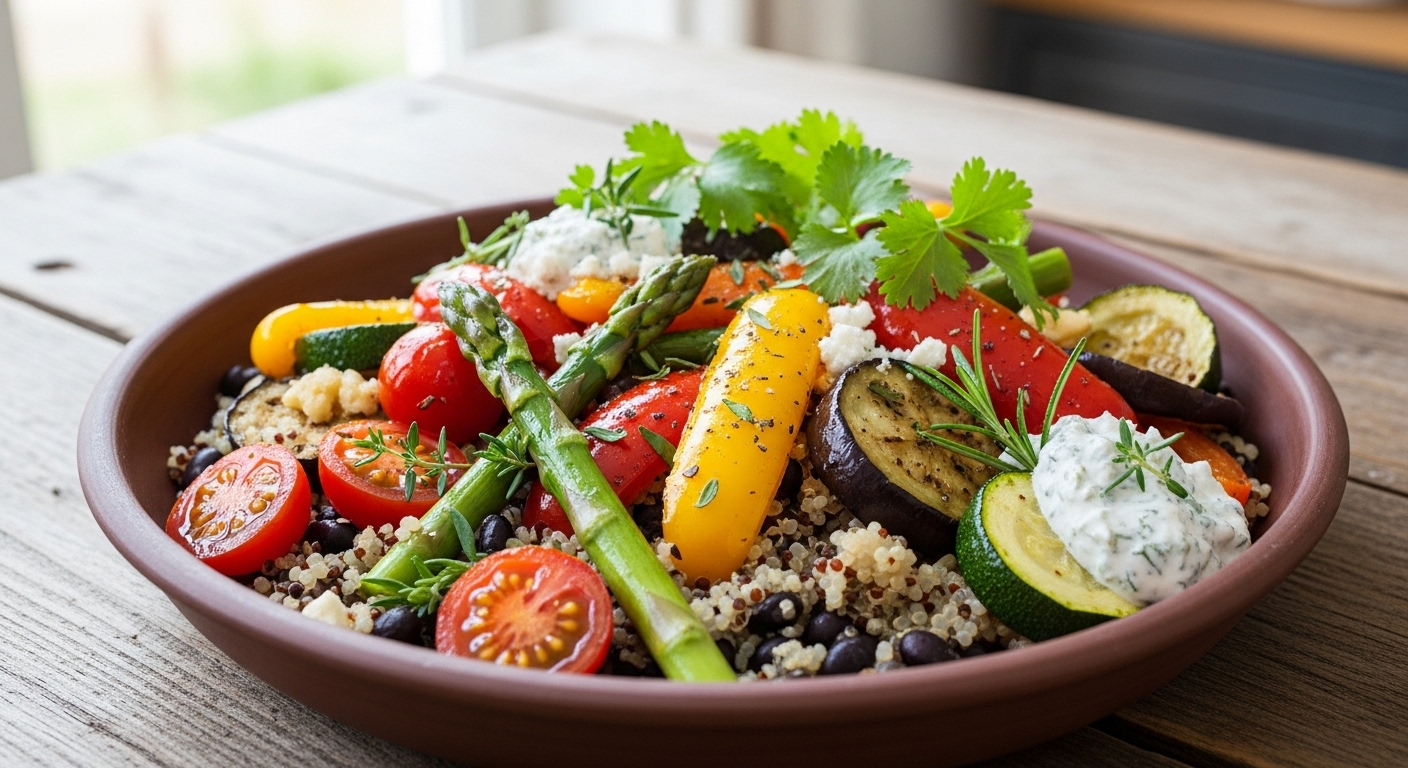
Have you ever felt lost in Japan thinking, “I just want to eat vegetables—but what’s actually safe to order?” In Japan, many broths and seasonings include fish-based dashi, which often surprises vegetarian travelers.
This guide explains the common food culture challenges for vegetarians in Japan—what ingredients to avoid, how to find vegetarian options at convenience stores, useful Japanese phrases for ordering, and how to choose meals at major chain restaurants. You’ll also learn how to request vegetarian meals at hotels and ryokan inns, what to do when you’re in trouble, and how to enjoy traditional Buddhist “shojin ryori” cuisine.
Use this practical guide to discover how to eat safely and comfortably as a vegetarian in Japan while experiencing authentic Japanese food culture.
Why Vegetarians Struggle in Japan and How Japanese Food Culture Works
In Japan, many soups, sauces, and seasonings contain fish or seafood ingredients, so eating out can be tricky for vegetarians. Even dishes that look plant-based, such as miso soup or udon noodles, often include bonito-fish broth (katsuobushi dashi). Since most restaurants do not clearly label vegetarian options, it’s essential to ask in advance.
The good news is that more vegetarian-friendly restaurants and temple-style dining spots are appearing, especially in tourist areas. Prices vary by location—specialty vegetarian restaurants in Kyoto or Tokyo tend to be higher—but knowing the basics of Japanese food culture and the best areas to find vegetarian meals will make your trip smoother and safer.
Ingredients to Avoid in Japan and Hidden Dashi Traps
Japan is surrounded by the sea, so even vegetable-based dishes often include fish stock called dashi. Miso soup, udon noodles, and simmered dishes frequently use bonito flakes (katsuobushi), which are not vegetarian-friendly. Kombu kelp broth is safe, but some restaurants mix it with fish-based stock. When dining out, politely ask, “Does this contain fish broth?” to be sure.
Common ingredients vegetarians should avoid include bonito flakes, dried shrimp, fish sauce, and gelatin. Since many ingredient labels are written only in Japanese, use translation apps or ask staff when in doubt. Vegetarian restaurants might cost slightly more, but they offer peace of mind and an authentic food experience. Doing some research before your trip will help you enjoy Japan safely.
Vegetarian Convenience Store Foods in Japan and Label Tips
Japanese convenience stores are surprisingly vegetarian-friendly and perfect for travelers looking for quick meals. Popular options include salads, fruit cups, rice balls (plum or kombu), tofu, and nuts. Most items cost between ¥100–400, making them affordable snacks. However, even kombu rice balls may contain fish stock, so checking the ingredient label is essential.
Avoid products listing “katsuodashi” (bonito broth), “gyokai extract” (seafood extract), or “gelatin.” Check the back label carefully, or ask staff if you’re unsure. Translation apps and vegetarian-friendly search apps can help you quickly identify safe products. With a bit of care, you can enjoy healthy and inexpensive vegetarian meals anywhere in Japan.
How to Order Vegetarian Food in Japan: Useful Phrases
Many Japanese restaurants don’t clearly mark vegetarian dishes, so communicating your needs is key. Here are a few simple phrases that can make dining easier:
- “Do you have any dishes made only with vegetables?”
(Yasai dake no ryōri wa arimasu ka?) - “Does this contain fish stock?”
(Sakana no dashi wa tsukatteimasu ka?)
Some restaurants may charge a small extra fee for custom meals, but most are happy to accommodate requests. Remember, many soups or sauces contain fish or meat flavoring, so if unsure, ask: “Please recommend something without any fish or meat broth.” Knowing just a few phrases will make eating out in Japan far less stressful and much more enjoyable.
Vegetarian Options at Chain Restaurants in Japan
Major Japanese chains now offer more vegetarian choices than before. At udon shops, dishes like cold “zaru udon” or vegetable tempura can work—but be cautious, as most broths still contain fish. Prices range from ¥500–1,000, making them convenient and affordable options for travelers on the go.
At cafés, salads, bread, and dessert options are usually safer. If in doubt, simply ask, “Could you prepare this without fish stock?” Knowing how to communicate and what to expect will help you dine confidently. Chain restaurants are consistent, so once you find one that suits you, it’s easy to order without surprises.
How Vegetarians Can Enjoy Sushi, Ramen, and Set Meals in Japan
Sushi, ramen, and teishoku (set meals) are iconic Japanese foods, but they can be challenging for vegetarians. Safe sushi options include cucumber rolls and natto (fermented soy) rolls, though soy sauce and dashi-based soups may still contain fish. Sushi typically costs ¥100–300 per plate, while fully vegetarian sushi restaurants are rarer and often more expensive.
Most ramen soups use pork, chicken, or fish broth, but vegetable-based ramen shops are increasing in major cities. For set meals, tofu dishes and stir-fried vegetables are safer choices, though sauces may still use animal-based ingredients. The best approach is to research vegetarian-friendly restaurants in advance and confirm details with staff when ordering. With preparation, you can enjoy Japan’s classic foods without worry.
You might be interested in this
Vegetarian Meals at Ryokan and Hotels in Japan: How to Request Them
At Japanese ryokan inns and hotels, informing the staff about your vegetarian preferences in advance greatly increases the chance of enjoying a stress-free meal. When booking, mention that you would like “meals without animal ingredients” and ask specifically about the use of fish stock (dashi) or animal-based seasonings. Some places may charge a small additional fee, so it’s best to confirm the cost beforehand.
Each accommodation handles dietary requests differently. Some ryokan offer authentic Buddhist shojin ryori (temple cuisine), while others can prepare salad- or tofu-based meals. Because same-day changes are often difficult, contacting the property early by email or booking form is recommended. Clear communication and flexible menu suggestions will help make your stay more comfortable.
Shojin Ryori for Vegetarian Travelers: Traditional Buddhist Cuisine
Shojin ryori is a traditional Japanese Buddhist cuisine that uses no animal products, making it ideal for vegetarian travelers. Some temples and temple-style inns allow visitors to enjoy a full-course shojin meal featuring tofu, seasonal vegetables, and beautifully balanced flavors. Prices usually range from ¥3,000 to ¥8,000 per course, and in popular destinations like Kyoto, it’s considered both a cultural and culinary experience.
Note that certain places may still include eggs or dairy, so confirming ingredients beforehand is essential. Many restaurants also require reservations, so contact them early once your travel schedule is set. Experiencing shojin cuisine is a meaningful way to understand Japanese food culture while enjoying a completely plant-based meal.
Temple Cuisine in Japan: Experiencing Shojin Ryori
Temple cuisine, or shojin ryori, is deeply rooted in Japan’s Buddhist traditions. It features seasonal vegetables, tofu, and legumes, carefully prepared without meat or fish. Many temples across Japan now welcome tourists to try authentic shojin meals, offering not only delicious food but also a moment of peace and reflection. These meals have become one of the most unique cultural experiences in Japan.
You can easily find locations by searching online for “shojin cuisine” or “shojin ryori Japan.” These keywords will lead you to temples and restaurants where you can enjoy this mindful vegetarian dining experience.
Conclusion: Enjoying Japan as a Vegetarian Traveler
Since many Japanese seasonings and broths contain animal-based ingredients, vegetarian travelers may find dining in Japan challenging at first. This guide introduced common ingredients to avoid, vegetarian-friendly convenience store foods, useful ordering phrases, hotel and ryokan tips, and how to enjoy shojin ryori safely. Understanding these basics allows you to explore Japan’s rich food culture with confidence.
Learning about Japanese culture through food adds depth and enjoyment to your trip. For more practical travel insights, check out our related guides on Japanese dining manners and onsen (hot spring) etiquette to make your stay in Japan even more rewarding.

 日本語
日本語 中国語
中国語 Español
Español